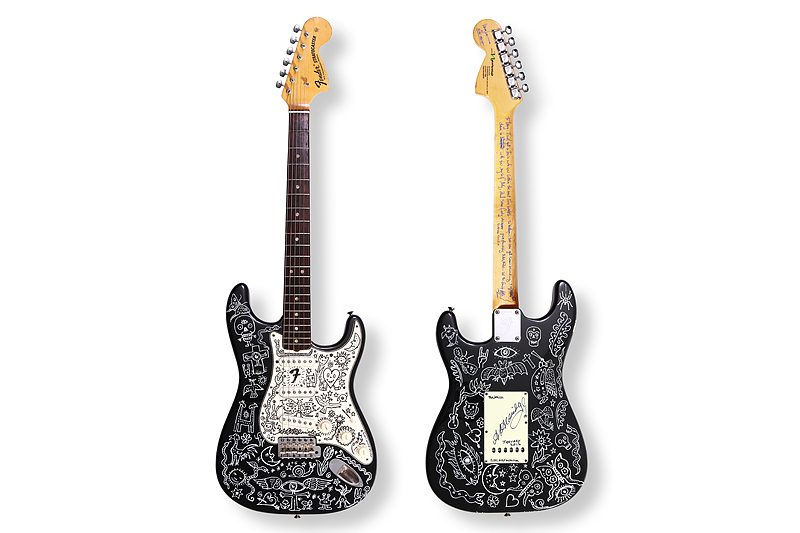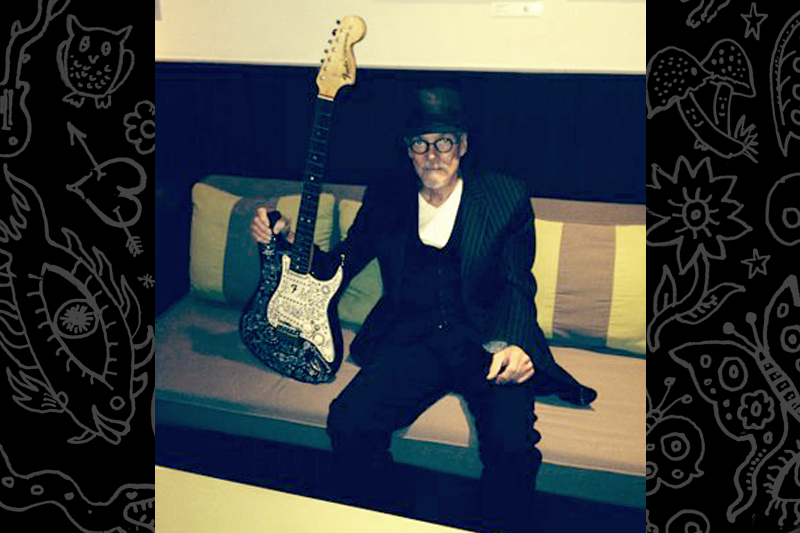The JimiLee Mojo Guitar
Jimi Hendrix and Alan Aldridge…
In 1970, Paul McCartney orchestrated a London listening party. Attending the party were Jimi Hendrix and Alan Aldridge. As the urban legend goes, when Alan walked into the party, Hendrix spotted the artist from afar. Hendrix cornered Aldridge and bombarded him with questions about art. They hit it off and that evening became fast friends.
During this time, the guitar greats, Clapton, George, John and Jimi, were experimenting with painting their guitars. Jimi decided he wanted the ultimate painted guitar, so naturally he commissioned his friend Aldridge, the most famous rock artist of that era. Aldridge accepted the commission and he and Jimi collaborated on ideas of how the guitar would look. Alan immediately began sketching out the guitar’s artwork. Tragically a few months later, Alan received the news of his friend Jimi’s passing.
Four decades later, the idea was resurrected and Alan was able to bring Jimi’s dream to fruition and make the guitar with digital art duplication. With the cooperation of the Hendrix estate, Fender® Musical Instruments and Hard Rock International®, the guitar was created and became a symbol of philanthropy for the above mentioned organizations.
How the JimiLee Mojo Guitar came to be…
Growing up in Memphis, Robert had been exposed to the musical luminaries of Stax and Sun Records. Eventually Robert’s own musical path led him to become friends with Larry Lee in October, 1969. Robert was working at Stax Records with Isaac Hayes and Larry wanted to meet him. The previous month, in September of 1969, Jimi Hendrix gave Larry Lee a 1969 Black Fender® Stratocaster®.
Robert had met Alan in 1974 in London when he was Guitarist for John Entwistle’s OX through a mutual friend Isaac Tigrett, the founder of the Hard Rock Café. In the 1990’s, Robert reconnected with Alan on various House of Blues projects and the latest reconnection between Alan and Robert ignited a brilliant idea… The universe kept bringing these two together and it was clear to Robert that Flying Mo-Jo would commission Alan Aldridge to paint the Larry Lee-Jimi Hendrix Guitar.
As Alan Aldridge never painted a guitar in his career, Flying Mo-Jo saw the historical significance in getting the Father of Rock and Roll Art to paint the Larry Lee-Hendrix guitar.
The result is the JimiLee Mojo Guitar. Alan painted it directly to the guitar without even sketching the artwork out. Upon completion, Alan christened it the JimiLee. The JimiLee Guitar is an amazingly mysterious and intriguing piece of art that has true Mojo and Alan’s distinguished look and feel. The JimiLee is an Alan Aldridge Masterpiece.
Quote from Larry Lee
“I first met Jimi Hendrix in 1962. I was a close friend of Jimi from 1962 to 1970. I played in several bands with Jimi including the Bonnevilles and the King Kasuals. In July of 1969 I got a call from Jimi to join a new band he was starting called Gypsy Sun and Rainbows. I moved to New York in July of 1969 to play with my friend Jimi Hendrix. I was in the New York area from July to October 1969. During this time, Jimi gave me many gifts, including some of his personal clothes, (which I wore his clothes at the famous Woodstock performance) a Marshall Guitar amplifier, some guitar pedals, guitar straps, and the above-mentioned Black Fender Stratocaster. Jimi gave me this guitar at the Navarro Hotel at Central Park South. This guitar first showed up at the ” SHOKAN HOUSE” in Woodstock in the summer of 1969, we were living with Jimi and preparing to record and rehearse for the Woodstock Concert. Jimi wanted me to have the Guitar and Jimi had many Guitars at the time.”— Larry Lee (Born March 7, 1943, passed away Oct 30, 2007)
Mr. Alan Aldridge
Alan Aldridge burst upon the creative scene of the sixties London just like The Beatles, with whom he worked. His imaginative designs and intoxicating, color-rich images captured the dreams and hallucinations of the psychedelic era for a generation, and for generations to come. In The Beatles Illustrated Lyrics, on the album covers for The Who, Cream, and Elton John, on the Notorious Chelsea Girls poster for Andy Warhol, and on innovative covers for Penguin Books, Aldridge fully expressed the spirit of his time. In the years since, his effervescent career has continued unabated, with Aldridge authoring bestselling children’s books such as The Butterfly Ball and The Peacock Party, designing the logo for the Hard Rock Café, and moving to Los Angeles, where he works on film and TV projects while designing for brands such as Incubus and Tears for Fears…
— excerpt from the book, The Man with Kaleidoscope Eyes, Abrams















